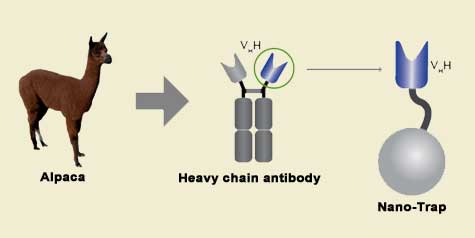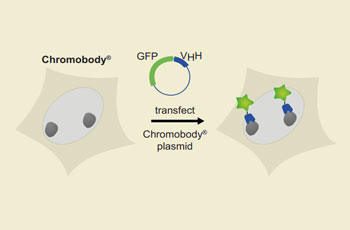Actin Chromobody Immunodetection Vector
Antibody Detection within Living Cells
A non-invasive way to trace actin dynamics in live cells
A new tool for detection of actin in live cells, the Actin Chromobody, lets you monitor the assembly or disassembly of the cytoskeleton or nucleus in real time. The small size of the Chromobody produces a high signal to noise for stunning, high resolution images or time lapsed movies of the cytoskeleton’s dynamics. Surprisingly, it has no influence on actin dynamics and exhibits extremely low toxicity of most cell types. Simply transfect the cell line of your choice with the Actin Chromobody plasmid. This plasmid contains the sequence of an actin-specific alpaca antibody fused to TagRFP or TagGFP (Evrogen). Upon transformation, your cells will express the Actin Chromobody. The cell’s cytoskeleton or nucleus lights up as the fluorescent Chromobody molecules specifically localize to actin proteins. The transient binding does not influence cell viability or motility and thus offers you a unique possibility to observe the cytoskeleton or nucleus in your cells. Use Actin-Chromobody to target and trace microfilaments in your cell line of interest, or as a marker of cellular morphology, or as a probe for cellular motility.
Live visualization of actin dynamics with Actin Chromobody
Actin Chromobody reveals actin dynamics in living cells. HeLa cells were imaged with confocal microscopy upon treatment with 2 µM of Cytochalasin D for 1 hour and recovery for 2 hours. Time lapse analysis shows actin reorganization.

Actin Chromobody highlights microfilaments in various cell lines. Shown are fluorescent images from cells transfected with Actin Chromobody fused to either TagRFP or TagGFP.


NIH 3T3 cells (murine fibroblasts) transfected with the nuclear Actin-Chromobody (TagGFP2, green) and the Lamin-Chromobody (TagRFP2, red) were starved in serum-free medium for 24 hours. Nuclear Actin-Chromobody-probed endogenous F-actin assembly and distribution is shown 30 s after stimulation with serum.
The nuclear Actin-Chromobody plasmid has been published and described by Prof. Dr. Robert Grosse, Institute of Pharmacology, BPC, University of Marburg, Germany under license from ChromoTek:
Matthias Plessner, Michael Melak, Pilar Chinchilla, Christian Baarlink, Robert Grosse (2015). Nuclear F-actin formation and reorganization upon cell spreading J Biol Chem.
Chromobodies turn your cells into immuno-reporter factories
Nanobodies are unique, small antibody fragments that exhibit the extraordinarily efficacious binding of a targeted protein. Expressed in animal cells, Nanobodies can be collected and used for in vitro studies. Something unexpected happened when Nanobodies were expressed as a fusion to a reporter molecule such as GFP. The newly formed Chromobody bound directly to its target within the cells in which it was being made. Moreover, using the correct vector and promoters, the binding has both high specificity and low background. This provides an excellent alternative to GFP-fusions with the protein of interest for immuno-localization studies. Why? Because GFP- and RFP-fusions have been shown to block or alter the activity of the fused protein. In contrast, Chromobody act in trans as a reporter that will not interfere with the normal function of the targeted protein.

Camelidae single-domain antibodies are like IgGs on steroids
The family of animals known as Camelidae (camels, llamas, and alpacas) produce functional antibodies devoid of light chains, so-called "heavy chain" antibodies. These heavy chain antibodies recognize and bind their antigens via a single variable domain. When cleaved from their carboxy tail, these barrel-shaped structures (2x3 nm) are extraordinarily small, naturally-occurring, and intact antigen binding fragments (MW of 13 kDa). These fragments, called Nanobodies, are characterized by high specificity, affinities in the low nanomolar range, and dissociation constants in the sub-nanomolar range (typically 10- to 100-fold better than mouse IgGs). The compact size of Nanobodies makes them extremely stable at temperatures up to 70°C, and functional even in 2M NaCl or 0.5% SDS. These small and powerful antibody fragments can be used in a variety of unique applications. They will open up your research possibilities.
Actin Chromobody Immunodetection Vector
|
SPECIFICATIONS
|
|
|---|---|
| Part Numbers | ACBRFP, ACBGFP, acg, acr |
| Vector Type | Mammalian expression vector encoding either the cytoskeleton marker Actin-VHH or nuclear marker VHH fused to green fluorescent protein TagGFP2 or TagRFP |
| Target Molecule | Actin |
| Reporter | TagGFP2 or TagRFP (from Evrogen) |
| Host Cells | Mammalian |
| Transfection Method | Transfect mammalian cells by any known transfection method. If required, stable transformants can be selected using G418 [Gorman 1985] |
| Propagation in E. coli | DH5alpha, HB101, XL1-Blue, and other general purpose strains
Incompatible with pMB1/ColE1 |
| Selection | Prokaryotic – kanamycin
Eukaryotic – neomycin (G418) |
| Replication | Prokaryotic – pUC ori
Eukaryotic – SV40 ori |
| Use | Non-invasive live cell visualization of endogenous cytoskeleton or nucleus |


